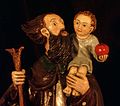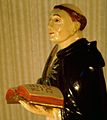Michael Cross
Michael Kreuz (born August 1, 1929 in Schlechtenberg near Aschau im Chiemgau ; † February 1, 2015 in Waging am See ) came from a Berchtesgaden family of artists and was a German wood sculptor .
Life
Kreuz was born as the third child of the wood sculptor Hans Kreuz senior and his wife Maria, née Seiser. He spent his childhood in Hohenaschau and Munich-Giesing . In 1944 he began an apprenticeship in a fish farm near Freising , from which he was released in 1948 after passing the journeyman's examination. After a four-year stay in the Capuchin monasteries in Laufen and Eichstätt, his father took him on as an apprenticeship as a wood carver in Tettenhausen am Waginger See. In 1955, Hans Kreuz released his son from training and moved to Söcking on Lake Starnberg . Michael Kreuz spent the winter of 1955/1956 with his father's sister in Milan and made several nativity scenes in the style of the Abruzzo costumes of the 19th century, which he exhibited in the Angelicum Minorite Monastery in Milan. Michael Kreuz stayed in Tettenhausen until the end of 1960, after which he bought a house in Waging am See and set up his own workshop there. In 1961 he married Anna Meier; the marriage produced a son and a daughter. In the early 70s of the 20th century, he exhibited some of his sculptures in the former Chiemgau palette, an exhibition forum for artists from Chiemgau and the surrounding area. On his 80th birthday he showed his life's work with all facets of his artistic repertoire once. His activity as a freelance artist ended in 2012 when he gave up his workshop in Waging and moved to the St. Martin retirement home in Waging am See. Until the end he was still busy with drafting namesake cartridges and saints. Michael Kreuz died unexpectedly of the consequences of the flu.
Artistic work
At the beginning of his artistic career, Kreuz was not only active as a wood sculptor, but also made decorative fonts. The focus of his work was in the field of Christian art throughout his life. He initially oriented himself towards role models such as Ernst Barlach and his father, but soon developed his own style. Reluctantly, until mid-1967 he also worked on pre-milled small figures from the former Alpenland publishing house in order to secure individual existence. Self-taught, he increasingly acquired knowledge and skills in barrel painting and in poliment gilding. With the support of his sister-in-law Lisl Kreuz , he was able to perfect his skills in gilding and silver plating. In addition to new orders for crucifixes, Madonnas, figures of saints and cribs, damaged carvings were regularly given to him for restoration. Here he was able to gain a lot of experience, so that commissioned work was brought to him by the church soon after moving to Waging am See. He mastered the true-to-style representations of sculptures from the Romanesque to the Rococo. Kreuz had a special talent in copying figures, for which he often only had a photograph available as a template. During his long life as an artist, Kreuz created very few works of his own accord. Here, however, his pronounced impressionistic streak was shown, which he was unfortunately only rarely allowed to live out, as this art did not match the preferences of his extensive clientele. Kreuz was not a sculptor of life-size or larger-than-life figures, he was a master of small sculptures, some of which were only 2 cm in length. His profane figures often reflect his subtle humor and his ability to observe human inadequacies.
Works by Michael Kreuz from a creative period of five decades
literature
- Supplement Traunsteiner Wochenblatt from November 4, 1967
- Traunsteiner Wochenblatt from June 26, 1971
- Waginger Seeblattl Summer 2004
- Brochure for the exhibition August 2009, self-published by Wolfgang Kreuz
| personal data | |
|---|---|
| SURNAME | Cross, Michael |
| BRIEF DESCRIPTION | German wood sculptor |
| DATE OF BIRTH | August 1, 1929 |
| PLACE OF BIRTH | Schlechtenberg near Aschau in Chiemgau |
| DATE OF DEATH | February 1, 2015 |
| Place of death | Waging by the lake |













